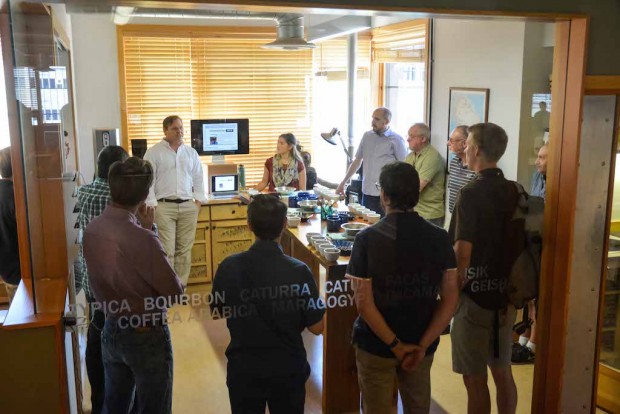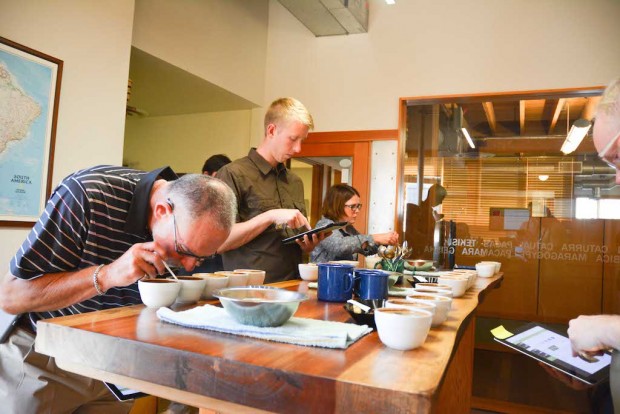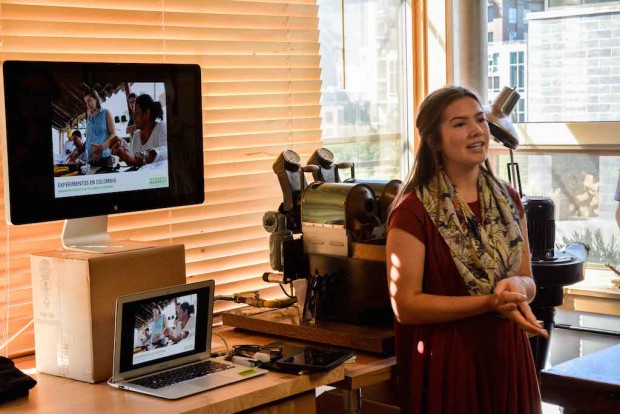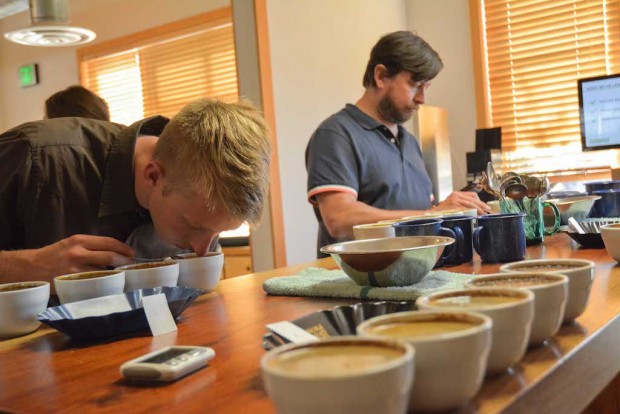A team of researchers and quality-control specialists from the relationship-pioneering green coffee importer Sustainable Harvest have presented initial findings from an initiative called Experimentos En Cafe, which supplies farmers at origin with an iPad-based toolkit designed to gather data and help determine best practices for post-harvest coffee processing. The specific goals of this first step in the project were to introduce the toolkit to a variety of farmers and gauge their interest and ability to use it, and then to gather an initial round of data to form a baseline for post-harvest refinements and experimentation.
Funded by the Dutch non-profit Progreso Foundation, the project set forth in early June with the delivery of toolkits consisting of an iPad, a pH meter, and a climate-reading NODE module to the hands of various smallholder farmers in northwestern Colombia associated with the Coop de los Andes, Coocentral, and Granja La Esperanza. Subject coffees came from lots on participating farms ranging in size from 2.5 to over 50 hectares.
After being taught how to use the equipment, farmers were encouraged to take climate readings at each stage of the harvest and post-harvest processes; take pH readings and pull samples from fermentation tanks upon dropping the coffee and then every two hours between hours 12 and 24; and save their collected information by entering it into an iForm database via a custom iPad app designed by Sustainable Harvest specifically for this project.
During a presentation of the initial findings at Sustainable Harvest’s Portland headquarters last week, program manager Katy Keisling reported that the introduction and engagement with the toolkits went very smoothly. Farmers of all ages and with variously sized plantations took to the technology almost immediately, excited to learn how to use it and for the information that it would gather. As far as the actual performance of the tools themselves, and the fluidity with which the instruments communicated with the programs meant to simplify the data — these were the areas with room for improvement.
“They’re using an iForm builder app that we’ve created specifically for those tools to drive into,” Quality Control Specialist Jessica Brooks told Daily Coffee News. “We have some improvements to make there. It was just a little clunky, to start. The idea is that in a further iteration of the tool, maybe it could be used in a specific application that’s cleaned up, that pulls the data a little more smoothly.” The NODE module communicates wirelessly via Bluetooth with the iPad, which pools the data, but could potentially do so with greater clarity and efficiency. “The data’s there, but what is this mass of data? How is it organized?” Brooks said these are the questions the app development team will address going forward.
Based partly on these issues and partly on farmers’ preferences for what data was most important to them, it was decided that data related to soil analysis, climate conditions and the color of the beans during fermentation would be sidelined in favor of greater focus on measuring pH levels over the course of fermentation. Now, the results of the cuppings of coffee samples pulled while monitoring pH are starting to take shape. “We’ve been cupping internally as the samples have come in,” Keisling said, noting that samples have also been sent out to participating roasters. “And then there are people cupping at our origin offices as well as the cooperative, but this was our main cupping event for the project.”
Spread out on Sustainable Harvest’s Portland cupping table were samples from each coop, pulled from fermentation tanks at designated intervals, for comparison. The pH level of the tank was noted for each sample pulled, and the differences the variably fermented samples displayed in the cup were remarkable. Participating in the cupping were several Portland roasters, one aspiring grower, Mario Fernandez of the Coffee Quality Institute, Sustainable Harvest CEO David Griswold, and other Sustainable Harvest personnel.
Attendees were provided iPads through which to use Sustainable Harvest’s Tastify app to evaluate each sample according to standard SCAA cupping protocols. The goal was to try to identify what correlation exists between cup quality, pH level and fermentation time for these particular coffees. In certain cases, the descending pH of the tank did not correlate to trends in attributes exhibited in the cup, which lead Fernandez to speculate if other factors were at play, such as the geometry of the tanks perhaps affecting the evenness of fermentation.
This was exactly the sort of insightful evaluation researchers hope to delve more deeply into, in hopes of providing farmers with information that could help them zero in on an ideal strategy for the fermentation stage of processing, using pH levels as a guideline. From there, farmers might also soon be able to identify what ambient factors contribute to the rate of change of pH in the fermentation tank. All of this could help them not only achieve the optimal levels more efficiently, but also replicate the ideal fermentation more consistently. “The replicability part is key,” noted Keisling. “We really want to see how focusing on an optimal pH level could help a farmer try to optimize that moment when they’re pulling their coffee.”
Some of the most advanced and best equipped coffee farming operations already have the means to take pH and other measurements, to hone their processing procedures. The absence of this technology on smaller farms with tighter resources, meanwhile, leaves the already-struggling farmers with yet another competitive disadvantage. Said Brooks, “The whole point of this toolkit is that it’s got to be something that’s affordable, and something that is realistic for farmers to be able to use.”
At the same time, simply the act of delivering these kits and having discussions with farmers at origin about their needs and desires yielded critical intelligence about how best to assist in production and processing in other ways going forward. Keisling mentioned that another element she heard a lot about from farmers that they were not able to measure with their existing toolkit was the moisture content of dried green coffee beans.
“That’s a critical, make-or-break variable for a farmer when they turn their green coffee over to the cooperative,” said Keisling. “If it’s not in the correct range, they have to either pay the cooperative to dry it longer, or they have to take it back and dry it themselves, and if they over-dry it, there’s no going back.” The Experimentos team is preliminarily thinking about finding a partner in tool development that’s capable and interested in creating a practical and affordable resource for farmers to be able to access that all-important measurement.
A moisture content tool implementation would constitute a “phase two” of this project if Sustainable Harvest is able to secure more funding from Progreso, or it could take on the form of entirely new project down the road. As for the ongoing work on the Experimentos En Cafe as they currently stand, cuppings of the first round of samples will finish within the next few weeks, with scores collected from all participating QC labs and roasteries by mid-September. Analysis of those results should be complete by the beginning of October.
For the immediate future, the close relationships between Sustainable Harvest’s Colombia origin office and the participating cooperatives will provide continued engagement with the farmers for feedback on their progress with the toolkit. While the team would love to expand the project to other origin countries, it’s still early days for the project overall. “Right now, our focus is really on evaluating the lessons learned in this initial phase,” said Keisling, “and refining the toolkit to the point that it provides clear, quality-oriented benefits to farmers.”
Howard Bryman
Howard Bryman is the associate editor of Daily Coffee News by Roast Magazine. He is based in Portland, Oregon.
Comment
2 Comments
Comments are closed.










Gratis!!!!
Great